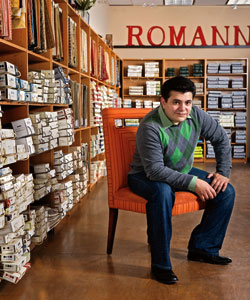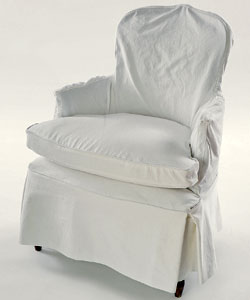To reupholster, or not to reupholster-that is often the question when thinking about redecorating, buying new furniture, or poking around estate sales and antique stores. Is it worth it to put money and time into giving an old sofa or chair a fresh outlook? If all springs point to yes, where do you go from there? We sat down with industry veteran Zaid Jimenez of Romann Custom Upholstery (773-777-1745; romann-custom.com) to bolster our knowledge of the ins and outs of the upholstery biz.
Jimenez learned the trade from his father, Romann, who started the business some 25 years ago in the basement of the family’s North Side home. The company grew steadily, and when Zaid graduated from Columbia College with an interior design degree in 2000, he expanded the family firm’s client base to include the design trade. Romann’s pros now keep busy doing work for Mart showrooms, interior designers, and commercial clients, as well as for a loyal residential clientele.
Quality control The first step: Determine whether the furniture is worthy of reupholstery. "I ask people where they bought the piece and what they paid for it," Jimenez says. "If they spent $2,000 for a sofa 20 years ago, then sure, the investment is going to pay off-you can spend a couple thousand dollars and have it look and feel like a brand-new $5,000 piece. Old furniture is generally better made than a lot of the medium-priced stuff that is available today. If it’s a $2,000 sofa from a big-box store that they sit on and watch TV every night, they are better off buying a new one."
The quality of the frame is key. Look for any warping or water damage, wiggle it to check stability, and lift it to feel the weight. "Maple is the best for a frame, and that’s a harder wood so it’s going to be heavy," Jimenez advises. "Poplar is a bit softer, but we use that a lot for repairs and new construction-it’s a great framing option. I’ve had people drop off pieces with frames made of plywood and two-by-fours. I call them and say "Let me just make you a new piece of furniture.’"
Next, check out the cushions, and don’t go by appearances alone. "Many dealers will slap new upholstery on top of old fabric, so it looks great but it’s hiding poor construction," our expert warns.

When it comes to upholstery, Zaid Jimenez has got you covered. |
Look underneath the piece to see if the bottom is bowing, and try to determine what kind of support system is in use. Eight-way hand-tied steel coil springs are a sign of superior support, and the more commonly used zigzag springs are also good-heavy snakelike wires that go from the front to the back of the frame, six to eight inches apart. Pieces that have webbed support systems with no metal are probably not worth reupholstering.
The shape of things What if you have a quality piece deserving of a redo, but the style is not to your liking or the fit isn’t quite right? Most upholsterers can alter, at least somewhat, the shape of a sofa or chair. "As long as it has a good frame, we can manipulate the design of the piece-add to the height of the back, chop down the arms, change a flared silhouette into a square tuxedo style. All kinds of things are possible," says Jimenez, who also makes furniture from scratch. He encourages clients to bring in a design or photo of something they like, but not to expect an exact copy. "I’m happy to take inspiration from furniture examples, but I don’t do knock-offs," he says. "That doesn’t make sense-why not just buy what you want, already made?"
The great cover-up Choosing fabric is the next step, and it can be intimidating. "We have over a million choices of swatches available to choose from," he says, "and access to millions more at the Mart." Prices start at around $25 a yard and can exceed $400 for high-end cloth. It helps to have some direction in mind before going in, so take color samples and photos of your space. To home in on the perfect selection, think about where and how you’re going to use the piece and how much you are ready to spend.
Can you provide your own fabric? "Sure," Jimenez says. "Some upholsterers will upcharge for cutting fabric a client provides, but we don’t. We can’t be responsible for it, however-if you call me with a problem down the line, well, it’s your fabric. If you find fabric at a warehouse sale for ten bucks a yard, there’s probably a reason it’s that inexpensive." He advises that you unroll the entire roll to check for flaws, and give it a stretch to make sure that it has tensile strength and it won’t tear with your hands. That means it’s dried out.
If you fancy a pattern, consider that you’ll need more fabric for the project, and that it will cost more in labor. "Small prints are no big deal," says Jimenez, "but when you have big plaids with varying colors and stripes that must be matched horizontally and vertically, or large damasks or toiles with great big bouquets of flowers that have to be centered, that takes a lot longer than just cutting, sewing, and applying a solid."
Consider the durability of the fabric as well as the pattern. "Chenilles and mohairs are usually very durable-old movie theatres used mohairs," says Jimenez. "Choose a low pile because it has tighter fibers and holds memory better. These are expensive, though, and in time will develop highlighted areas-the heat of our bodies pushes pile down in areas and these will catch the light differently." Another very soft yet durable material, according to Jimenez, is Trevira. "It is 100 percent polyester and was originally developed as a contract [for hotels, offices and the like] material-it costs over $100 per yard," he says. A tip: "Get a swatch and mistreat it-spill stuff on it and try to clean it, or take it to the dry-cleaners if it’s a solvent-based material. Throw it in the washer; see what happens."
Set on silk? "If you’re only going to use something on special occasions, you can get away with a dupioni silk, but that wouldn’t be a good choice for a bench that’s used every day. For that you’d need something with a tighter weave," says Jimenez. "There are different weights of silks, but you will definitely pay a lot more for the heavy weaves. We can also send delicate fabrics out to be knit-backed, which is a process of applying a knitted netting to the back of the cloth. It helps to deter raveling and stretching, but you’ll incur an additional mill set-up fee of $50 to $100, and then $4 to $8 per yard."
Most fabrics can and should be safely stain-guarded, with the exception of some suedes and silks, and this treatment can be applied at the factory or after a piece is finished. "It’s not like a plastic cover; it’s a liquid that helps keep staining agents from absorbing-you still need to blot up spills as soon as possible," Jimenez says. Romann can also provide traditional arm covers, or sleeves that extend to the seat and have a sleeker look.
All stuffed up Type of filling also demands consideration. Down is the most luxurious and costly but not always the wisest option, as feathers are natural fibers that break down, decay, and settle. More can be added over time, but it might be better to use a synthetic stuffing that has the same feel as down and won’t need to be constantly fluffed up. Jimenez recommends polyfoam as a good choice for most applications, as it is inexpensive, has longevity, and has a better memory. Shops have samples with different densities and grades to check out, so have a squeeze. If the depth of a sofa isn’t quite right-you’re sitting too shallow or too deep-an upholsterer should be able to adjust this by reducing or increasing the firmness of the filling in the back cushions.
Photograph: Katrina Wittkamp
Anatomy Lesson: Ever wonder what your furniture is made of?
|
ThreadCounts:
Alternatives for breathing new life into old furniture
 |
Slipcovers: “Slipcovers are great for three reasons. You can change home decor for the season; if you have kids or they get dirty, you can throw them in the wash; and if you’re not ready to reupholster, they are a transitional way to spruce up a piece—slipcovers cost about half the price of a re-cover. Tailored and tight is very popular; we can also do slightly loose, or full-blown shabby-chic. Bring the piece in, or we’ll pick it up—this is important for a good fit.” Jimenez prefers to work with pre-washed 100 percent cotton (“it doesn’t pucker,” he says), but if you like the look of linen, yet fear wrinkles, all hope is not lost. “A linen/cotton blend is better than all-linen, and there are different weights—stiffer is better, but some are impossible to upholster with,” he says. “Thinner linens could be knit-backed.”
Color: “There’s not a heavy color trend right now, like that tired chocolate brown/baby blue thing. But we are seeing a lot of vibrant, saturated colors, and people are not so afraid to experiment with them. Take a look at a West Elm or Design Within Reach catalog these days and you’ll see bright colors of furniture popping against dark backgrounds—a far cry from the tone-on-tone, beigey pages that were dominant five years ago. It’s hard to even find a true black upholstery fabric because it’s not selling. And everyone is done with brown.”
Indoor/Outdoor Fabrics: “Fabrics developed for commercial use in restaurants or hotels have come a long way, and are terrific for residential spaces such as sunrooms, pool areas, and any indoor area that gets heavy usage. There are new products that are durable yet pleasant in texture and great looking, not at all scratchy or feeling like canvas. You can even get indoor/outdoor chenilles—expensive, but so beautiful.”
Green: “Sustainable, eco-friendly fabrics started being used in the commercial and hospitality industries simply because they use more volume, but they’re slowly creeping into residential usage. I think people are realizing that reupholstery is intrinsically green because it means reusing furniture rather than trading it in for new. They are buying quality pieces and taking care of them, with the idea that they can be around for generations. It’s more bang for the buck anyway, in the long run.” Slipcovers will get you more mileage, with less commitment
Add-ons: “Decorative touches like tassels, nail heads, and braided cording are popular ways to individualize furniture, as long as they are used with restraint. We make our piping individually, so seams can be edged with a contrasting fabric, and if one section gets worn it can be easily replaced. We can do a French welting, which is puffy and sewn by hand, attached to loose cushions. Be careful with piping, though, as you don’t necessarily want to visually frame out a whole sofa.”
Photography: Katrina Wittkamp



